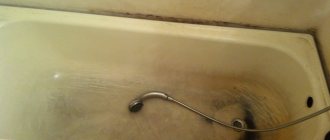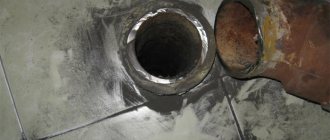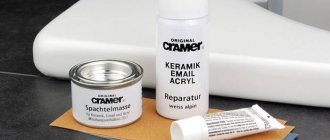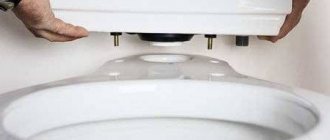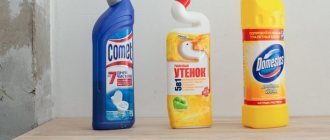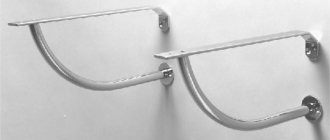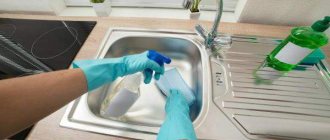Despite the emergence and active use of modern materials for the manufacture of sanitary equipment, the popularity of cast iron bathtubs still remains at a fairly high level. These heavy, clumsy products easily outperform acrylic and steel models that are more varied in shape and color, due to their performance characteristics.
In addition to low thermal conductivity, high strength and durability, they are famous for their maintainability, due to which an old cast iron bathtub can easily be updated using affordable materials. In this article we will tell you how to restore a cast-iron bathtub, returning it to its original cleanliness, smoothness and shine without unnecessary hassle.
Features of restoration of cast iron bathtubs
A cast iron bathtub is a practical and durable plumbing fixture with a long service life, good strength properties and significant weight, which, depending on the size of the model, can reach up to 500-600 kg. Cast iron itself is black, but the white color of the product is given by the enamel, on the surface of which minor damage, cracks, and color changes occur during operation.
Restored bathroom
Restoring a cast iron bathtub has the following features:
- The thickness of the walls of a cast iron washing container is 0.6-0.8 cm, so models made from this material are considered more repairable compared to thin-walled steel products. Restoring a cast iron bathtub is possible even with fairly deep damage.
- The service life of high-quality cast iron plumbing equipment exceeds 50 years, but the enamel coating on the inner surface of the bowl wears out much earlier. If you restore the enamel, the restored device will be almost like new, so restoring a cast-iron bathtub with your own hands is cost-effective.
Note! High-quality cast-iron bathtub models are quite expensive; for a spacious product with a length of 160-170 cm you will have to pay at least 20 thousand, and corner bowls cost several times more. Therefore, do not rush to throw away your old bathtub; it is better to return it to its attractive appearance through restoration.
General information about enamels
Paint for bathtub restoration is made on the basis of perchlorovinyl, polyvinyl chloride and other resins. The components meet environmental safety requirements. They harden quickly, after complete evaporation of the solvent. They are sold ready for use.
Coatings can be matte or glossy, most often white. To obtain a color shade, tinting paste is added. Apply with a brush or spray onto a cleaned and degreased surface that needs to be dried.
Compositions containing 2 components are among the most durable compared to aerosols, which contain a large proportion of solvent. It makes the enamel consistency liquid, and the applied surface layer becomes thin and fragile.
Restoration with liquid acrylic
You can quickly and effectively repair a cast iron bathtub at home using liquid acrylic. Thanks to the unique texture and consistency of this modern polymer, restoration of the enamel layer is faster and easier than using epoxy enamel. Acrylic compounds consist of 2 components - acrylic itself and a hardener. The ingredients of the mixture are combined and then thoroughly mixed until a fluid, plastic mass is obtained. Restoration of cast iron products occurs as follows:
- First, the damaged hot tub is prepared for use, thoroughly cleaned of dirt, and chips and cracks are sanded with zero-grit sandpaper. Then the surface is degreased, heated and dried.
Bathtub restoration scheme using liquid acrylic - While the font is drying, a compound is prepared to restore the enamel. The ingredients of the mixture must be combined in a container, and then mixed thoroughly until a homogeneous mass of thick consistency is obtained.
- Apply liquid acrylic using the pouring method, starting from the far side of the bowl and moving in a circle. Pour the polymer in a thin stream so that it reaches approximately the middle height of the bath.
- Then the acrylic coating is leveled with a rubber spatula. However, if it does not turn out perfectly smooth, do not despair - the polymer will level out during the drying process.
Important! In order for a restored cast iron plumbing fixture to last longer, it is necessary to follow the acrylic drying technology. Polymerization of this polymer lasts 36-48 hours, during which contact of the coating with water or dust should be limited.
Bathtub enameling
Opening the bathtub with new enamel is the oldest method, which is very similar to the process of painting with paint, but at the same time a special composition is applied to the surface of the product. There are 2 varieties of these mixtures in the assortment of stores:
- Professional enamel. It has a fairly liquid consistency. When using it, it is necessary to open it in several layers. The application process requires significant effort and is almost impossible to carry out without the appropriate skills.
- Enamel for self-application. It is distinguished by its greater thickness compared to professional mixtures, which makes it much easier to open surfaces with it.
The method itself consists of applying enamel to a previously prepared cast-iron bathtub using a paint brush or roller. The second tool is used much less frequently when performing this work.
Advantages of the method:
- The least expensive method from a financial perspective.
- During its implementation, you do not have to resort to installation work that relates to connecting the drain and overflow.
- Versatility. In this way, you can update products that are made not only of cast iron, but also of steel.
Disadvantages of the method:
- The applied enamel is significantly fragile, which is why extreme care must be taken when handling it. When it is opened, the surface acquires increased sensitivity to mechanical damage. Quite often, during use, after some time, chips appear on the bathtub painted with it.
- The drying period of the applied coating is quite long. Its final completion occurs within up to 7 days.
- The enamel is opened in a thin layer, which is why it cannot hide significant defects present on the surface. It does not allow you to remove dents, large chips, and other damage from view.
- After some time, the fresh coating often acquires a yellowish tint.
- The service life of enamel applied to the surface of a cast iron bathtub rarely reaches more than 5 years.
How to choose the right enamel
The characteristics and service life of the applied enamel coating largely depend on the quality of the mixture used. The experts themselves recommend taking into account a number of the following criteria when choosing:
- Method of applying enamel. The range includes mixtures that can be applied using a roller, brush or spray. The latter tool is the most suitable for this task, allowing for the most uniform opening.
- Hardener tone. The composition for cold enameling consists of two and, much less frequently, three components. The hardener is one of the components. If it is dark yellow, dark red or brown, then an undesirable tint may appear on the finished coating.
- Shade of the mixture. If necessary, the enamel mixture can be opened in any color. There are special colors for this task, which are sometimes even immediately supplied with the enamel or purchased separately. Experts recommend choosing the shade of the coating in the very room in which the product is located.
- Complete set used for restoration. The more complete it is, the better. Together with the enamel, tinting pastes and special compositions are supplied to prepare the bathtub for restoration work.
In practice, it is best to use a roller or paint brush to open fairly thick mixtures of two components, for example, Epoxin 51 and Epoxin 51C, which are excellent at filling small defects that exist on the base.
Preparing the bath for enameling
You need to start by removing the top glossy layer of enamel, for which you should perform a thorough treatment with an abrasive, with which you need to remove about 30-50 microns of gloss. To do this, you can resort to using sandpaper, abrasive powders or a grinder with a special grinding wheel installed. You can achieve the desired result especially quickly with the help of a flap disk, using together with it an abrasive paste, which you can make yourself.
To do this, use grated laundry soap and mix it with abrasive powder for sandblasting in a ratio of 1:3. Experts advise using ground nickel slag with a fraction of no more than 0.16-0.18 mm.
The elements must be thoroughly mixed and filled with water. Next, the paste should be kept for 24 hours. As a result, a viscous mixture is formed that resembles fairly hard plasticine.
Next, you should use it to process the entire bowl and immediately pass it with a petal circle. The process must be performed 1-2 more times until the base becomes rough and dull.
Note! Complete removal of the enamel is not required. If the surface begins to darken significantly, treatment should be stopped.
Next, you need to wash the bowl well, dismantle the overflow and siphon, clean untreated areas and install the siphon in its original place for a while.
At the next stage, you need to degrease the surface, but in this case it is better to do chemical etching, which adds porosity to the coating structure and removes deep limestone deposits and rust stains. As a result, a fresh layer fits much better and its service life increases significantly.
If there are ingrained rust stains on the base, then it is necessary to begin removing them. To do this, you can use special solvents.
At the end of the reaction, the stain will spread and turn pale, which at this time must be rinsed with water. This must be done before the mixture dries, since otherwise the rust will not be removed from the pores of the coating. The application process itself is as follows:
- First of all, the surface should be opened with a 3.5% solution of hydrochloric acid. The procedure must be performed several times with a break of 6-7 minutes.
- After this, you need to thoroughly rinse and apply bleach, which should be diluted with water to a paste.
- The solution must be left on the base for 20 minutes, and after this period of time, rinse off.
Note! When using acid and lime, be sure to wear a respirator, since during the reaction they release toxic fumes.
- Next you need to dry the surface of the bowl using a hairdryer.
- Then it is necessary to degrease to eliminate all reagent residues. To do this, use a lint-free cloth soaked in acetone, gasoline or trichlorethylene.
- After complete processing, the bowl must be dried.
Applying enamel to a cast iron bathtub
Before you start painting in the bathroom, you need to carry out a wet cleaning, during which you will be able to remove the dust generated during the work, which can settle on the surface of the freshly applied enamel. Otherwise, conspicuous, unattractive, rough spots will appear on the glossy surface; therefore, to avoid their formation during opening, the doors in the room should be closed or covered with plastic film.
At the next stage, if necessary, the composition used should be prepared, while observing all the requirements and recommendations specified by the manufacturer in the instructions. Then you can begin applying the finished solution to the surface of the bowl. It is most convenient to carry out the opening using a spray gun, with which the paint is sprayed from a distance of about 30 cm. The application itself should be done with short cross strokes so that the solution easily moistens the surface of the bath.
There is no need to make the layer too thick. The cup needs to be opened several times. Each layer should be applied as evenly as possible. The second coating must be opened on top of the first after 15-20 minutes, and all further ones with an interval of half an hour. Upon completion of the work, the applied solution must be completely dry, for which the door to the room must be closed well and entered only after 24 hours.
Opening with a paint brush is done a little differently. First of all, when using it, it should be taken into account that fluff may remain on the surface to be painted, which must be removed with a thin needle.
During application, the brush is dipped into the prepared solution, and then it must be used to make several vertical lines, after which they must be rubbed with horizontal strokes. Therefore, the entire surface of the bowl should be thoroughly painted. The enamel layer must be applied as evenly as possible so that there are no stains or missing areas. After applying the first layer, you don’t have to wait for it to dry completely and start opening the next one.
When used, this painting technique makes it possible to reduce the number of drips to a minimum. If they form, you need to use a thin brush and carefully stretch them upward. Once all layers of enamel have been applied, interaction with the painted surface should be avoided until it has completely dried.
Note! Before renewing the coating of a cast-iron bathtub, it is advisable to make sure the quality of the paint brush you are using by checking that lint does not fall out of it.
Rules of operation after secondary painting with enamel
The reapplied mixture differs significantly in its qualities from the primary coating, which is applied in production using special equipment, which is why during use you will need to adhere to a number of the following rules:
- Avoid using abrasive cleaning compounds, since the strength of the surface painted with new enamel is an order of magnitude less than the original one. For this you can use exclusively liquid products.
- It is necessary to avoid impacts, and also to prevent objects from falling into the bathroom, which could cause damage to the coating.
- It is advisable not to fill the repainted bowl with too hot water. Initially, it is recommended to pour a certain amount of cold liquid and only then add hot liquid to it.
Repair with acrylic liner
If the surface of a cast iron washing container is in disrepair, if most of the enamel surface is covered with damage, it is problematic to properly repair it using epoxy enamel or liquid acrylic. To restore the appearance of heavily damaged products, a more radical method is used - installing an acrylic liner. In this case, restoration occurs as follows:
- An acrylic liner is selected according to the shape and size of the cast iron bathtub.
Acrylic liner - The acrylic insert is adjusted to fit the washing container being repaired using a hacksaw or sandpaper.
- The inner surface of the bowl is cleaned and degreased, and then a special adhesive composition for acrylic is applied to it.
- An acrylic liner is placed inside the bathtub, the drain hole is plugged, and then the bathtub is filled with water. In this case, the water acts as a press, facilitating the gluing of the liner.
Installing an acrylic liner
Remember that the cost of an acrylic liner for a cast iron bathtub is higher than restoring an old cast iron bowl with liquid acrylic or epoxy enamel. But using the insert allows you to repair products with through holes and a heavily damaged surface.
Preparing a bathtub for enameling or acrylic application
So the technologies are different, but the preliminary preparation procedure is always the same. Before restoring the bathtub, you need to remove dirt and a layer of damaged coating. It is important that there is maximum adhesion between the cast iron and the applied layer.
The work cannot be completed without:
- Cleaning powder, solvent.
- Textile-based sandpaper, for example P24.
- Construction hair dryer, grinder, screwdriver.
- Fast-hardening automotive putty.
- Vacuum cleaner, plastic film, masking tape.
- Use a soft wide brush, lint-free cloth.
Step 1
step 2
step 3
step 4
step 5
step 6
First of all, clean the bathroom with abrasive detergents. Before you think about how to update your bathtub, you need to purchase everything you need, including sponges. There should not be a shortage of warm water. But this is at the washing stage. Before restoring the bathtub enamel, it is necessary to remove the old one. To do this, use sandpaper. Rub until characteristic scratch marks appear. There is no need to wash off the dust. By the way, it makes sense to wash the enamel by hand in the bathroom wearing, if not a respirator, then at least a gauze bandage and dust glasses.
The process can be speeded up if you use a grinder with a special grinding attachment. In any case, this device will be useful, since before restoring the enamel of the bathtub, the surface must be sanded, which is difficult to do manually. The process is labor-intensive and, without power tools, takes a lot of time and takes no less effort. Only after the initial processing can the chips be washed off and the metal etched with alkalic acid. You will have to work in chemical-resistant rubber gloves.
The acid will take a long time to corrode. It needs to be neutralized, for which a soda solution with water is used. And after this, you need to do the following procedure 2-3 times :
- Fill the bathtub to the brim (up to the side), blocking the shut-off drain.
- We wait 10-15 minutes until all chemical processes are neutralized.
- Drain the dirty water and wipe the surface with a dry cloth.
The rags should be such that no fibers or lint remain after use. It’s even better to dry the sides and bottom with a hair dryer. Before repairing the bathtub, it must be completely dry. Now it is important to identify all the shells and defects. To do this, a visual inspection is carried out. If a defect is discovered, before enameling the bathtub, you need to putty all the holes. To do this, apply automotive metal putty, and after it dries, sand the surface until it becomes perfectly smooth.
All dust is sucked off with a vacuum cleaner. Residues are wiped off with a dry cloth. To enamel, the bathtub must be treated with a solvent. This will degrease the surface and ensure reliable adhesion to the paint. When the reagent dries, go over it again with a dry soft cloth. Remove the shower hose. Each tap and all spouts are wrapped in plastic wrap. You will have to dismantle the drain and disconnect the shut-off pipe. It is important that nothing interferes, and that water cannot in any way get into the container until the enamel is dry.
How to repair chips or minor restoration of damage to a bathtub
Whereas in the past you would apply epoxy and then sprinkle it with porcelain powder, there are now more effective methods for repairing chipped enamel. Toothpaste is no longer mixed with glue, as this is a solution for a couple of weeks.
Professionals use the following step-by-step instructions:
- Remove corrosion with a special product.
- Thoroughly wash and dry the work area.
- The area is degreased with acetone, alcohol or solvent.
- Apply automotive putty and level with a spatula.
- Sand the area to make the surface smooth.
- Paint the problem area with auto enamel or special paint.
Special repair kits are also sold, which include everything you need, including instructions. However, such a set costs from 800 to 1300 rubles.
Video - repairing chips and even through holes in a metal bathtub
This video instruction is for those who decide to repair the coating themselves with their own hands. The master will show you what needs to be done at all stages, from preparatory measures to the application of waterproof painting material. If you save the link to this page, you can always watch the master class again. And if you ever drop something heavy and damage the enamel, you can correct the situation at any time. And even if the hole is through, act as the master advises, and you will not have to buy a new bathroom.
Restoration methods, their advantages and disadvantages
There are several basic methods for repairing the enamel layer. They can be used for different stages of defects. If you choose the right option, the result will be high quality and will last a long time.
There are several basic methods for repairing the enamel layer.
Enamel painting
Applying new enamel is suitable when there are no large flaws and a layer cannot hide them. The method is not difficult and inexpensive. But the result is short-lived, the average service life of enamel is 5 years. There are aerosol enamels, or regular enamels, which are applied with brushes or rollers.
Applying new enamel is suitable when there are no large flaws and a layer cannot hide them.
Liquid acrylic
Acrylic is a suitable option for treating the surface of a bathtub; it is more durable than enamel, lasting up to 10 years. Does not acquire a yellow tint over time, there is no chance of getting bubbles when applied, the layer will be smooth. When using, do not forget about the operating rules.
Drying lasts 1.5 days, but the layer is covered. The downside is that it requires experience from the master to apply it well, or preliminary training is required.
Acrylic is a suitable option for treating the surface of a bathtub; it is more durable than enamel, lasting up to 10 years.
Acrylic insert
There are special bowls on sale that duplicate the shape of the bathtub. They are simply attached to glue and serve for many years, up to 15 years. The choice of colors is also varied.
This option is easy to implement and does not require additional skills from the master. The only thing you need to do is choose the right liner so that it fits the cast iron bathtub perfectly. It is not possible to find the desired form in all cases.
This option is easy to implement and does not require additional skills from the master.
Advantages and disadvantages of bathtub restoration at home
If we talk about the positive aspects of repairs, there are savings in money. At the same time, the bathtub acquires a beautiful external design and lasts longer.
The disadvantages are that the work is somewhat difficult; attentiveness is required from the master. Not everyone gets an acceptable result. Also, while the surface is drying, it cannot be used; the process can be long.
The bathtub acquires a beautiful appearance and lasts longer.
Properties of cast iron as a bathroom material
The cast iron base requires care when working; it is hard, but fragile; in order to obtain the required shape, you have to try hard. This limits the options for creating bathtubs; the following characteristics of cast iron can be distinguished:
- The wear resistance and durability of the material is impressive, but the decorative enamel layer is not so durable and requires restoration after some time;
- Low noise level when drawing water into the bathroom, the process does not cause unnecessary discomfort;
- Amenable to repair if necessary;
- Slow rate of heat loss, basking in warm water will last longer than in other bath models.
Slow rate of heat loss, basking in warm water will last longer than in other bath models.
